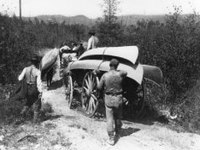ALGONQUIN R & R
Algonquin Provincial Park, “7600 square km of wild rugged beauty” quoth The Raven, Algonquin Park’s official newsletter, found between latitudes 45 degrees 10 minutes – 46 degrees 10 minutes and longitude 77 degrees 30 minutes – 79 degrees 15 minutes, within the Madawaska Highlands of the Laurentian Shield. The Precambrian Shield is the oldest portion of the continent and was subjected to intense glaciation. Before the park was created evidence indicates a scarcity of animals. Explorer David Thompson complained of the lack of wildlife in the park area. Before him Champlain said of the park area: “…quite a wilderness, being uninhabited except by a few Algonquin savages who dwell in the country and live by the fish they catch in the ponds and lakes with which the country is well provided.”
With interest in the Muskoka area developing along recreational lines the Algonquin Region remained isolated from the rest of the province and the private preserve of the lumbermen. Conservationists of the time were conscious of the need to protect the flora and fauna of the Algonquin Region. In many ways the environmental concerns were not dissimilar to today’s. An ecological theme permeated the thoughts of those interested in setting aside an area such as Algonquin Park.
Between the settlers who torched the forest to hasten clearing the land for farming and the lumbermen who were wastefully hurling the pine these conservationists saw that man’s destruction of the forest not only marred nature’s beauty, it upset the harmony and natural balance of life. The wanton destruction of the forests altered climate, eroded the soil, led to destructive flooding and eliminated wildlife. The premise that man is only a lifetime custodian of God’s world and therefore obliged to leave it at least as well off as found underlined the conservationist philosophy of the time. And so when the suggestion to set aside a vast tract of land within some reasonable distance of Ontario cities was put forth the benefits of retaining a forest was ‘inestimable’.
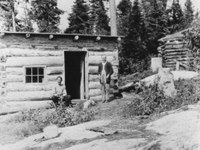
Algonkin Forest and Park was established in 1893 to protect fish, game, landscape and forests. As the timber would be the park’s main source of revenue it was essential to harvest the mature timber wisely and the concepts of multiple use and sustainable development were introduced. One of the six objectives for creating the Algonkin Forest and Park was to establish a health resort for rest, relaxation and recreation. Instead of travelling to the United States or Europe for their vacations the government hoped that people would find this an attractive alternative. Tuberculosis was a common illness and government ads claimed: “the idea appears to be well founded that pine forests are of specific value in the cure of lung disease.” In 1895 a government report favouring hotels in the park stated: “such hotels will be enabled to offer visitors air, scenery, and opportunities of exercise such as they will hardly find elsewhere.” To justify such action it went on to say: “as in Europe where it is common to allow a few hotels…in the large forests possessed by European governments.” This report continued: “This large reservation…will eminently be capable of affording the citizen…the means of passing summers surrounded by every pleasure which varied scenery can afford, amid the perfect repose of a district almost uninhabited by man.” Although permanent residences should not be allowed, temporary summer cottages were encouraged. A survey cost $10.00, annual land rental $7.50 for a maximum of two acres and the lease lasted 21 years.
In 1908 the Grand Trunk Railway opened Algonquin Park Station and the Highland Inn at Cache Lake, site of the park headquarters. The Inn could accommodate 100 guests plus it provided ‘tabins’ (tents on wooden platforms) for any overflow guests. In 1925 it cost $45 per month. The hotel was torn down in the mid-50’s.
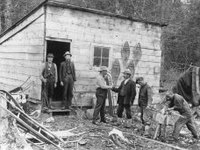
In 1912/13 the Grand Trunk Railway (GTR) opened Nominegan on Smoke Lake and Minising on Big Island Lake. Each consisted of a main lodge including a dining room, assembly hall and bedrooms plus several cottages well supplied with bathrooms and open fireplaces. To reach these destinations one experienced a variety of travel including train, stage and boat. For example, to reach Minising one left the train at Joe Lake and had the choice of travelling by stage 11 miles over rough corduroy road sufficient to ‘jolt your brains’ or hire a guide and paddle.
Under Superintendent Millar the park Rangers operated a sugar bush but low profits co-inciding with the Rangers’ busiest time of the year for patrols made it a short lived venture.
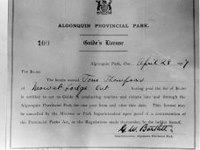
In 1923 Dr. Henry Sherman of California bought Minising and established a religious retreat to study the life of Christ. It operated into the 1940’s. Tom Thomson had painted Nominegan Point, the setting for the GTR lodge of the same name. Fellow artist Lawren Harris stayed at the lodge where the rates were $2.50-$3.00 per day; $16-$18 per week. The guests would leave the train at Joe Lake Station, cross Canoe Lake by canoe or rowboat, portage to Smoke Lake and then, by boat, continue to Nominegan – luggage and all, rain or shine. When some unknown assailant drowned a family of skunks near the lodge’s drinking water intake an alternate source was quickly arranged. In 1926 the cabins at Nominegan burned and the lodge was later sold to A.G. Northway in 1931. Note: While researching this article the author came across a photo of his wife’s grandfather tending the gardens at Nominegan. An avid gardener he was also Northway’s Chief Fur Buyer. Northway’s used to rival the T.E. Eaton Company in Toronto at one time.
The Hotel Algonquin, at Joe Lake, was owned and operated by the Colsons and could accommodate fifty people in addition to another fifty in tents. Mowat Lodge, Canoe Lake, was formerly the Gilmour Logging Company’s headquarters. It could accommodate 25. It also housed the post office when the name changed from Mowat to Canoe Lake. Owner Shannon Fraser often met his clients at the train station in his horse drawn hearse. Tom Thomson and many of his fellow artists often used Mowat Lodge as their park HQ. Mowat burned in 1920; was re-built and burned again in 1930 after which the Frasers left Algonquin. In 1922 Superintendent Bartlett retired. In 1923 his son Alf bought the Bell cottage at Cache Lake, across from park H.Q., and opened Bartlett’s Lodge. Still operating, the lodge recently expanded its season to operate during some of the winter months.
Rose Thomas, ‘the most photographed girl in the park,’ moved to Cedar Lake in 1928 where her family operated Kish Kaduk Lodge. The train stopped at Brent and the guests then travelled by boat to the island lodge. Thomas, and her cousin Jack Wilkinson, an avid photographer to whom we owe credit for many park photos, ran the lodge into the early ‘70s. This writer rented tents for his Cashel Lake Junior Rangers circa 1973 for a canoe trip in the area from Rose and Jack. During that summer the J.R. Camp at Achray was closed due to Beaver Fever.
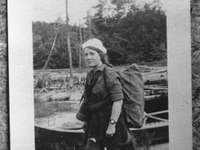
Under the direction of Superintendent Bartlett shelter houses for park Rangers on patrol popped up like mushrooms. By 1936 there were 115. Air patrols diminished the need for these cabins but canoe trippers found them a welcome retreat from nasty weather. However some bad apples vandalized these cabins causing the then Lands & Forests to burn all non-essential interior buildings during the late 1960s.
Fanny Case, of Rochester, New York, a pioneer in women’s education, philosophized that classroom walls were not an ideal background to the learning experience. In 1908 she approached Superintendent Bartlett. Case wanted to establish a girls’ camp at Cache Lake. At Northway, no relation to A.G., the girls learned nature lore, music, crafts and to swim. Basically they learned to constructively use their leisure time – a lifelong pursuit. Canoe trips were considered to be too arduous for girls but Case hired Ernest Finlayson, a University of Toronto Forestry grad, to teach the “camping arts” and to plan the canoe trips. Such detail included the maximum weight each girl could pack over a portage.
The first summer of 1908 everyone had to pitch in and help construct the campsite. Happily, they discovered that this provided ‘half the fun’ of camping and so, each day, time was set aside for work on camp projects. This activity developed the spirit of cooperation as everyone felt an important part of ‘making Northway work.’ Each person’s contribution was a valuable asset to her collective success. These camper initiatives developed skills and encouraged a camp loyalty, a sense of pride in their forest home.
During one summer so many forest fires raged that the local youth camps had to help. When a fire broke out at Camp Ahmek local residents rushed to the rescue as the older boys were already off fighting fires at Tea Lake. In the bucket brigade was a Roman Catholic Priest and a United Church Minister working side by side causing one wit to remark that “for once the churches were working together to defeat a common foe.” Even Ernest Thompson Seton, famous for his wildlife stories (“Wild Animals I have Known”) inspired by camping in the Don Valley, attempted to operate a youth camp from 1931-34. The depression took its toll and Mrs. M. Kates took possession of the camp in 1935 and opened Camp Arowhon.
Due to the shortage of manpower during World War Two, park youth camps often helped maintain portages, patrols for fire, fought fires, and, in general, keep an eye out for the park. In 1944, from this initiative, Maurice Kirkland, a high school teacher and former ranger, worked out the details and developed the Ontario Junior Rangers Program which today is called Ontario’s Rangers, a program for 16-17 year olds.
In 1913 the Provincial Parks Act stated: “The Algonkin National Park is hereby continued under the name Algonquin Provincial Park.” Bruton and Clyde Townships were added in 1961 when 80,000 people visited the park. Since 1978 the park has attracted 8,000,000 tourists. Record numbers are predicted for Algonquin Park’s centennial in 1993.
This article was first published during the summer of 1992.
